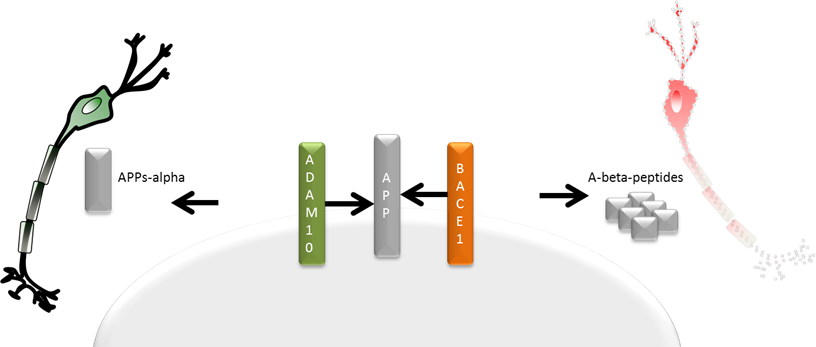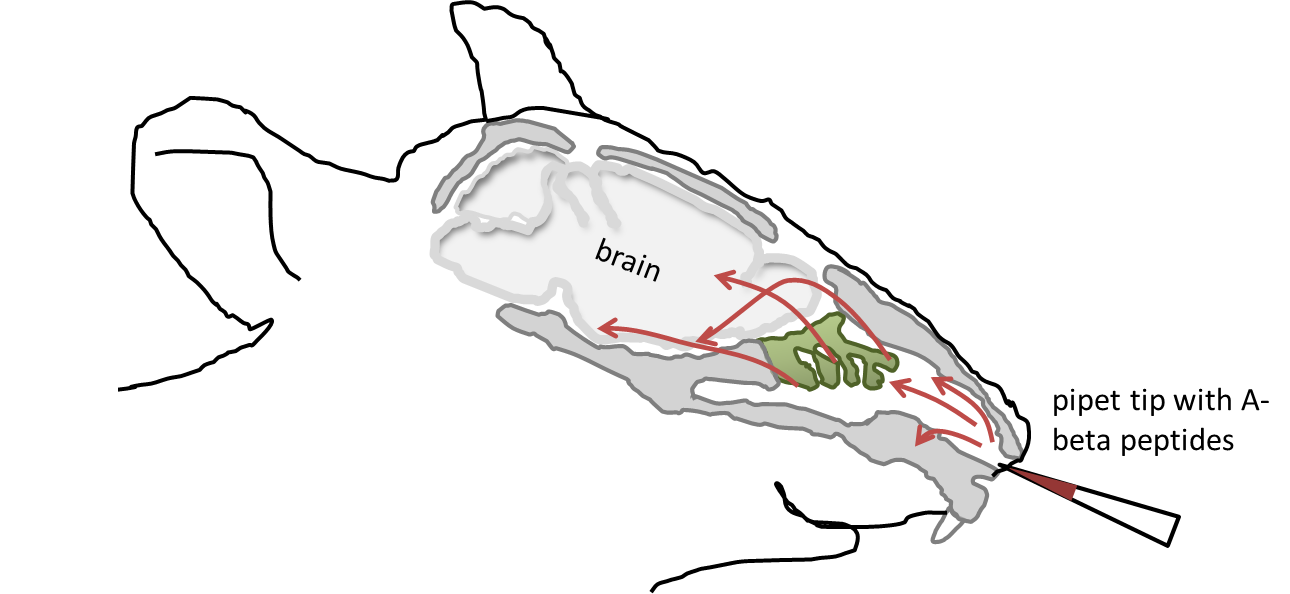Alzheimer’s disease is the most prominent type of dementia in the aged population. About 30 million people are estimated to develop the disease in the next 30 years and the financial as well as social burden will be of immense size. Therefore, establishing successful therapeutic strategies is an urgent need. This requires appropriate research models and knowledge on pathogenesis.
For only a small number of patients is the origin of Alzheimer’s disease obvious: genetics. About 1-3 % of all humans affected carry mutations in three genes that are closely linked to Alzheimer’s disease.
One of them encodes a protein presented at the cell surface which is needed for communication of neuronal cells and is called the Amyloid precursor protein (APP). This protein is cut by several enzymes into smaller pieces that inherit different functions. The cleavage product, suspected to also evoke Alzheimer’s disease in the sporadic, non-genetic variant, is the Amyloid-beta peptide which finally forms depositions (plaques) within the patients’ brains.

Almost all animal models which are used to investigate Alzheimer’s disease are based on the genetic variant of the disease. Introduction of the three mutated genes found in the rare genetic variant of the human disease into the mouse genome forms the basis for those research models. Therefore, these models are relying on a prerequisite that does not fit the majority of the diseased humans, as patients with sporadic Alzheimer dementia are not carriers of these mutations.
Injection of Amyloid-beta peptides directly into the brain of mice is an alternative approach to mimic the toxic effect of the pathological peptide. It has been shown that such an application of pure peptides is able to evoke changes on the molecular as well as on the behavioral level in the treated animals that resemble clinical features of the patients. For example, learning and memory, tasks that are severely disturbed in Alzheimer patients, are also diminished in Amyloid-beta injected mice.
However, an injection right into the brain needs specialized equipment and experienced investigators. In our study, we therefore aimed at establishing a model for Amyloid-beta-induced pathological changes that allows the investigation of typical symptoms of Alzheimer’s disease and is easy to exert.
The nose-to-brain route represents a direct gateway for administering substances to the brain. Intranasal administration utilizes three main delivering pathways for material to the brain: the olfactory, the rostral migratory stream, and trigeminal routes. This in consequence leads to a fast delivery that targets nearly all brain areas from olfactory bulbs through to the hindbrain. Especially in rodents, the nasal cavern consists of a huge surface that allows the animal olfactory orientation and facilitates transnasal delivery of drugs and substances.

A solution containing Amyloid-beta peptides was funnelled into the nostrils of wild type mice and distribution of the peptide as well as consequences for learning and memory were examined. Only one hour after administering the peptides, corresponding signals were measurable throughout the whole brain. Besides a high concentration of the peptide in brain regions in close proximity to the nose, the cerebellum, which is located far away from the nostrils, also indicated occurrence of the Amyloid-beta peptides.
Moreover, mice treated with the Amyloid-beta peptides showed impaired learning and memory in a conditioning test. Mice were trained in a single session to correlate a tone or a certain environment with a mild electric foot shock. On the next day the tone or the environment were presented again and the mice asked to show their capability of memorizing the unpleasant situation by a behavior that is called “freezing”. When animals were treated before the training day intranasally with Amyloid-beta peptides, they showed a 50% reduced memory as compared to control-treated mice.
Although further detailed investigations have to unravel how comparable this new mouse model is to the complex human disease, it presents an easy to handle tool for investigating pathological changes due to Amyloid-beta peptide, one of the major players identified in sporadic Alzheimer’s disease. This might be used for analyzing Amyloid-beta-targeted therapeutic approaches and the investigation of specific pathomechanisms in the future.
Comments